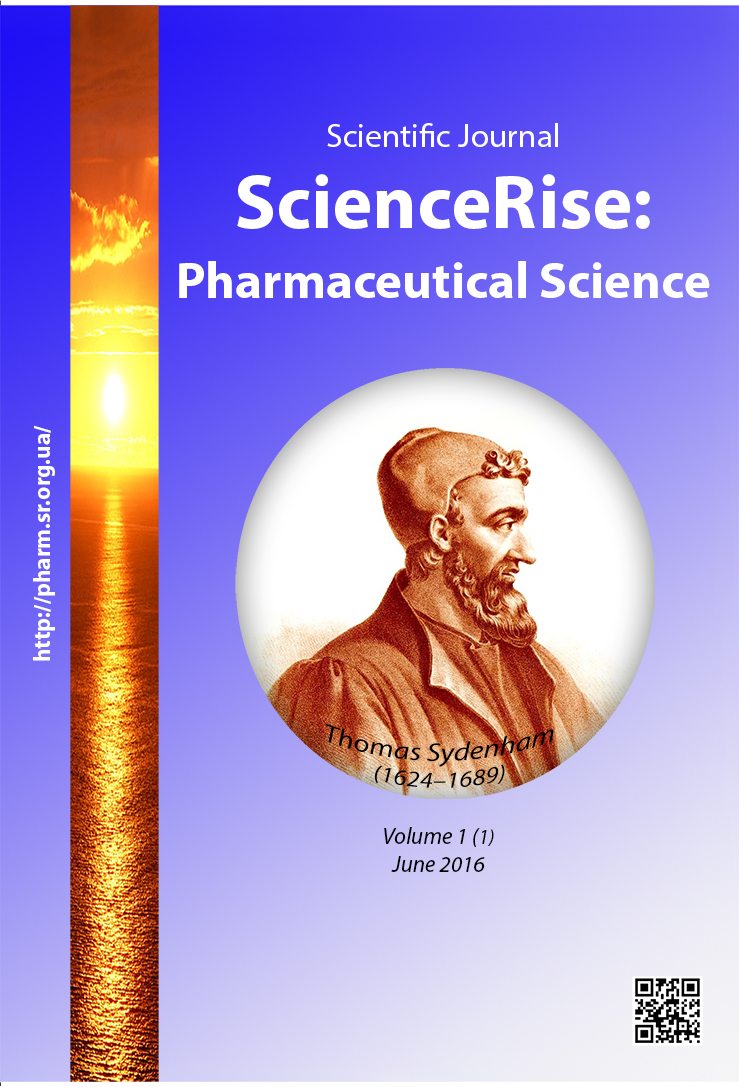Influence of dry herbal extracts on pentylenetetrazole-induced seizures in mice: screening results and relationship “chemical composition – pharmacological effect”
DOI:
https://doi.org/10.15587/2519-4852.2016.71518Keywords:
medicinal plants, extracts, seizures, screening, “chemical composition – pharmacological effect” relationshipAbstract
Aim. Screening of 48 dry extracts of plants belonging to 18 species of 8 families not studied before on anticonvulsant activity, to analyze the chemical composition for the extracts with proved anti- and proconvulsant activity, and to estimate the connection of the effect of herbal products and their phytochemical composition.
Methods. On the model of pentylenetetrazole-induced seizures in mice the influence of 48 dry herbal extracts with varied chemical composition has been investigated. Extracts were standardized by the content of alkaloids, flavonoids and polyphenols according to European Pharmacopoeia methods (HPTLC, HPLC, UPLC, GC-MS).
Results. By the integral indicator of efficacy – reduction of the mortality rate – it has been found that 11 of herbal preparations have significant anticonvulsant properties, 10 extracts act as proconvulsants, and the remaining 27 extracts have practically no effect on experimental convulsions. It has been established that there is a relationship between the pharmacological effect of preparations and phytochemical composition of the plant being extracted as well as the host species (for parasitic species – Viscum album) and the degree of polarity of the extracting agents. For the extracts with expressed anti- and proconvulsant features the chemical composition has been investigated.
Conclusion. The detailed analysis of relationship between phytochemical composition and influence of the extracts on the experimental seizures has found that anticonvulsant peculiarities of extracts most probably depend on rutin high content, but for the herbal medicines with proved proconvulsant properties the role of individual biologically active compounds has not been definedReferences
- Kumar, S., Madaan, R., Bansal, G., Jamwal, A., Sharma, A. (2012). Plants and Plant Products with Potential Anticonvulsant Activity – A Review. Pharmacognosy Communications, 2 (1), 3–99. doi: 10.5530/pc.2012.suppl1.2
- Nsour, W. M., Lau, C. B.-S., Wong, I. C. K. (2000). Review on phytotherapy in epilepsy. Seizure, 9 (2), 96–107. doi: 10.1053/seiz.1999.0378
- Pitkänen, A., Schwartzkroin, P. A., Moshé, S. L. (2005). Models of seizures and epilepsy. Amsterdam: Elsevier, 712.
- Tsyvunin, V. V., Shtrygol’, S. Y., Prokopenko, Y. S., Georgiyants, V. A. (2012). The screening investigation of anticonvulsant activity of dry extracts from 8 species of plants of the families Solanaceae, Papaveraceae, Lamiaceae and Polemoniaceae. Clinical Pharmacy, 16 (4), 47–50.
- Akdogan, I., Goksin, N. (2011). Experimental Epilepsy Models and Morphologic Alterations of Experimental Epilepsy Models in Brain and Hippocampus. Underlying Mechanisms of Epilepsy, 4, 269–283. doi: 10.5772/19928
- Tsyvunin, V. V., Shtrygol’, S. Y., Prokopenko, Y. S., Toryanik, E. L. (2014). Experimental defining of anticonvulsant action of perspective phytogenic anticonvulsants. Ukrainian Biopharmaceutical Journal, 3 (32), 45–49.
- Rho, J. M., Sankar, R., Stafstrom, C. E. (2010). Epilepsy: mechanisms, models, and translational perspectives. Boca Raton: CRC Press, 684. doi: 10.1201/ebk1420085594
- Medina, J. H., Viola, H., Wolfman, C. (1997). Overview – Flavonoids: A New Family of Benzodiazepine Receptor Ligands. Neurochemistry Research, 22 (4), 419–425.
- Rang, H. P., Maureen Dale, M. (2003). Pharmacology. Edinburgh: Churchill Livingstone, 797.
- Sweta, V. R., Lakshmi, T. (2015). Pharmacological profile of tropane alkaloids. Journal of Chemical and Pharmaceutical Research, 7 (5), 117–119.
- Gupta, P. C., Sharma, N., Rao, C. V. (2012). A review on ethnobotany, phytochemistry and pharmacology of Fumaria indica (Fumitory). Asian Pacific Journal of Tropical Biomedicine, 2 (8), 665–669. doi: 10.1016/s2221-1691(12)60117-8
- Reza, H. M., Mohammad, H., Golnaz, E. (2009). Effect of methanolic extract of Hyoscymus niger L. on the seizure induced by picritoxin in mice. Pakistan Journal of Pharmaceutical Sciences, 22 (3), 308–312.
- Crawford, P. (2001). CPD – Education and self-assessment: Epilepsy and pregnancy. Seizure, 10 (3), 212–219. doi: 10.1053/seiz.2001.0562
- Holmes, L. B., Harvey, E. A., Coull, B. A., Huntington, K. B., Khoshbin, S., Hayes, A. M., Ryan, L. M. (2001). The Teratogenicity of Anticonvulsant Drugs. New England Journal of Medicine, 344 (15), 1132–1138. doi: 10.1056/nejm200104123441504
Downloads
Published
How to Cite
Issue
Section
License
Copyright (c) 2016 Vadim Tsyvunin, Sergey Shtrygol’, Yuliya Prokopenko, Victoriya Georgiyants, Nataliya Blyznyuk

This work is licensed under a Creative Commons Attribution 4.0 International License.
Our journal abides by the Creative Commons CC BY copyright rights and permissions for open access journals.








